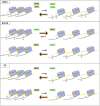Epigenetic disorders: Lessons from the animals-animal models in chromatinopathies
- PMID: 36225316
- PMCID: PMC9548571
- DOI: 10.3389/fcell.2022.979512
Epigenetic disorders: Lessons from the animals-animal models in chromatinopathies
Abstract
Chromatinopathies are defined as genetic disorders caused by mutations in genes coding for protein involved in the chromatin state balance. So far 82 human conditions have been described belonging to this group of congenital disorders, sharing some molecular features and clinical signs. For almost all of these conditions, no specific treatment is available. For better understanding the molecular cascade caused by chromatin imbalance and for envisaging possible therapeutic strategies it is fundamental to combine clinical and basic research studies. To this end, animal modelling systems represent an invaluable tool to study chromatinopathies. In this review, we focused on available data in the literature of animal models mimicking the human genetic conditions. Importantly, affected organs and abnormalities are shared in the different animal models and most of these abnormalities are reported as clinical manifestation, underlying the parallelism between clinics and translational research.
Keywords: Danio rerio; animal models; chromatinopathies; drosophila melanogaster; mus musculus; rare diseases.
Copyright © 2022 Di Fede, Grazioli, Lettieri, Parodi, Castiglioni, Taci, Colombo, Ancona, Priori, Gervasini and Massa.
Conflict of interest statement
The authors declare that the research was conducted in the absence of any commercial or financial relationships that could be construed as a potential conflict of interest.
Figures



References
-
- Alarcón J. M., Malleret G., Touzani K., Vronskaya S., Ishii S., Kandel E. R., et al. (2004). Chromatin acetylation, memory, and ltp are impaired in CBP+/- mice: A model for the cognitive deficit in rubinstein-taybi syndrome and its amelioration. Neuron 42, 947–959. 10.1016/j.neuron.2004.05.021 - DOI - PubMed
Publication types
LinkOut - more resources
Full Text Sources
Molecular Biology Databases

